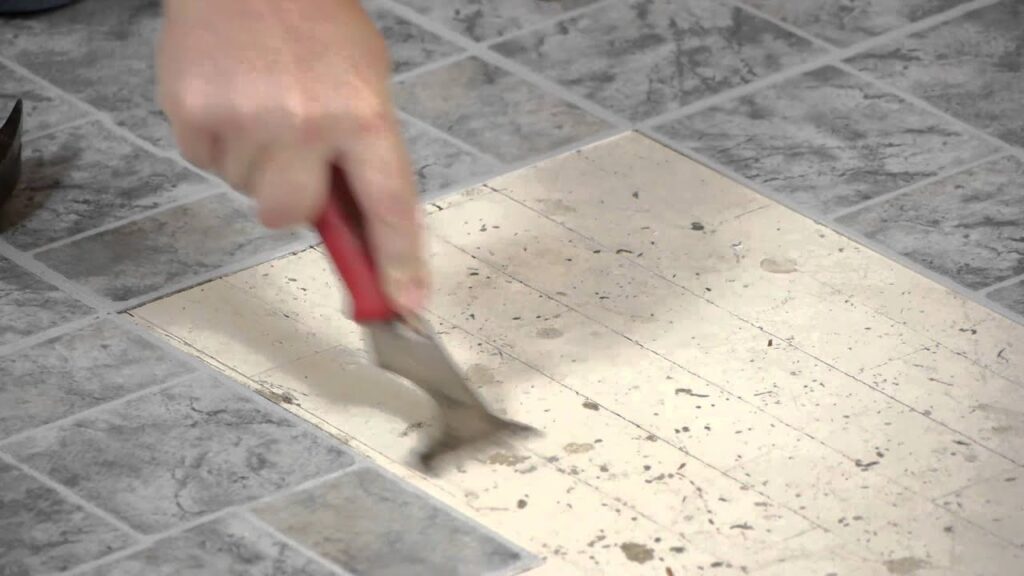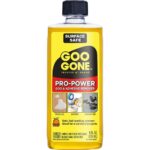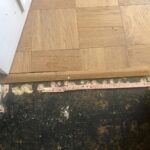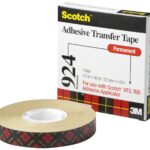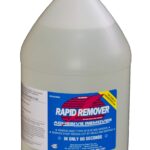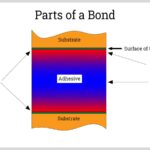Removing vinyl adhesive can be a tricky task. Firstly, it is important to determine the type of adhesive you are dealing with. Some vinyl adhesives can be removed with a solvent-based adhesive remover. The remover should be applied directly onto the adhesive and allowed to sit for a few minutes before wiping it away with a clean cloth. For particularly stubborn adhesive, you may need to employ a heat gun to loosen the adhesive before applying the remover.
Be sure to exercise caution when using the heat gun as it can cause the vinyl to become irreparably damaged. In some cases, you may need to use a razor blade to scrape away the adhesive. If you do choose to use a razor blade, you should do so very carefully and be sure to use a blade designed for this purpose. It is generally recommended to avoid using harsh chemical solvents or abrasives when removing vinyl adhesive. If you do use them, make sure you take all necessary safety precautions and test on a small area first. Finally, when trying to remove adhesive, it is important to take your time and to be patient. There is no need to rush the process as this can lead to scratches and other damage. With patience and the right tools, you can easily remove vinyl adhesive.
How to remove tape adhesive from vinyl flooring

Removing tape adhesive from vinyl flooring can be a tricky task, but it doesn’t have to be impossible. To begin, you should start by softening the adhesive with a heat gun or hair dryer. This will help to loosen the adhesive and make it easier to remove. Next, you can use a putty knife to gently scrap off the softened adhesive. Be sure to scrape in the direction of the flooring’s grain, being careful not to damage the finish.
Once the majority of the adhesive has been removed, use a cloth dampened with warm water and a mild detergent to remove any remaining traces. Scrub in the direction of the grain, then dry the area with a clean, dry cloth. If you are still having difficulty removing the adhesive, you may want to try using a chemical adhesive remover. Follow the instructions carefully and test the product on a small, inconspicuous area first. Finally, if the adhesive remover does not work, you can try using a paint-and-varnish remover. Make sure to wear protective gloves and follow the manufacturer’s instructions. Be sure to rinse the area with warm water and a mild detergent after using the remover.
How to remove old glue down vinyl flooring with ease?
Removing old glue down vinyl flooring can be a tedious task, but with the right tools and techniques, it can be completed with ease. First, you must remove any excess pieces of vinyl flooring from the surface. This can be done with a putty knife, scraper, or a razor blade. Make sure to wear protective gloves to protect your hands from sharp edges. Next, you must dissolve the adhesive that is holding the vinyl to the surface.
To do this, several different products can be used, such as mineral spirits, white vinegar, or a commercially available adhesive remover. Once the adhesive has been sufficiently loosened, you can use a putty knife or scraper to remove it from the surface. Make sure to scrape in the direction of the grain to avoid damaging the flooring. Finally, you can use a damp cloth to wipe away any remaining residue. If necessary, use a stronger solvent, such as acetone, to get rid of tough spots. Removing old glue down vinyl flooring doesn’t have to be a difficult job. With the right tools and techniques, you can remove vinyl adhesive with ease.
How can I remove a stain on my vinyl floor?
Removing stains from a vinyl floor can be a tricky process. The first step is to identify the type of stain and determine the best cleaning solution. For stubborn stains, a mixture of warm water and a mild detergent can help. You can also use a specially-made vinyl floor cleaner, or a natural solution like white vinegar. When dealing with adhesive on vinyl floors, it is important to use a non-abrasive tool such as a plastic scraper to remove any excess.
If the adhesive is still present after scraping, you may need to use a special adhesive remover. Be sure to read the instructions carefully and follow the safety precautions provided. Once the adhesive is removed, use a damp cloth and a mild detergent to clean the area. Rinse the area with warm water and dry with a soft cloth. If any of the stain remains, repeat the process until it is completely gone. To prevent future stains on vinyl floors, you should regularly clean and mop the surface. Cleaning the floor with a soft brush or cloth is recommended. You can also use a vacuum cleaner to remove dirt and debris. Be sure to use a vacuum cleaner that is specifically designed for vinyl floors. Finally, it is important to use a vinyl sealant on your floors to help protect them from dirt and water damage. By following these steps, you can effectively remove vinyl adhesive and stains from your vinyl floors. With regular cleaning and maintenance, you can keep your vinyl floors looking their best.
How to remove Sharpie from vinyl flooring?
Removing vinyl adhesive from a vinyl floor can be a tricky process. Fortunately, there are a few steps you can take to get rid of any Sharpie stains on the vinyl. First of all, you’ll need some rubbing alcohol. Soak a clean cloth in the alcohol and dab the stain gently. Keep rubbing the stain until it fades away.
If this doesn’t work, you can try using a mixture of one part white vinegar and two parts warm water. Again, soak a clean cloth in the mixture and dab the stain until it fades away. If the Sharpie stain still won’t budge, you can try using a mild detergent and a damp cloth. Rub the stain gently with the detergent and rinse it with warm water. Finally, if the stain still won’t go away, you may need to use a vinyl cleaner. Make sure to follow the instructions on the cleaner carefully, as some cleaners can actually damage the vinyl. By following these steps, you should be able to remove Sharpie stains from vinyl flooring and restore it to its original condition.
What is the best adhesive for vinyl flooring?
Removing vinyl adhesive from a vinyl floor can be a difficult task. To make the process easier, it’s important to choose the right adhesive when laying the vinyl floor. The best adhesive for vinyl flooring is one that is specifically designed for this type of floor. This type of adhesive is usually made from PVC and a high-performance synthetic rubber compound. It forms a strong bond between the vinyl floor and the subfloor, making it very difficult to remove.
The best way to remove vinyl adhesive is to use a combination of solvents and mechanical abrasion. This will help break down the adhesive and make it easier to remove. Start by using a solvent to soften the adhesive, then use a scraper or brush to scrape away the softened material. Once the majority of the adhesive has been removed, use an abrasive material such as steel wool to remove any stubborn residue. Finally, use a damp cloth to remove any remaining adhesive. By following these steps and using the right adhesive, you can ensure that the vinyl floor adhesive will be easy to remove when necessary.
How to get adhesive off vinyl
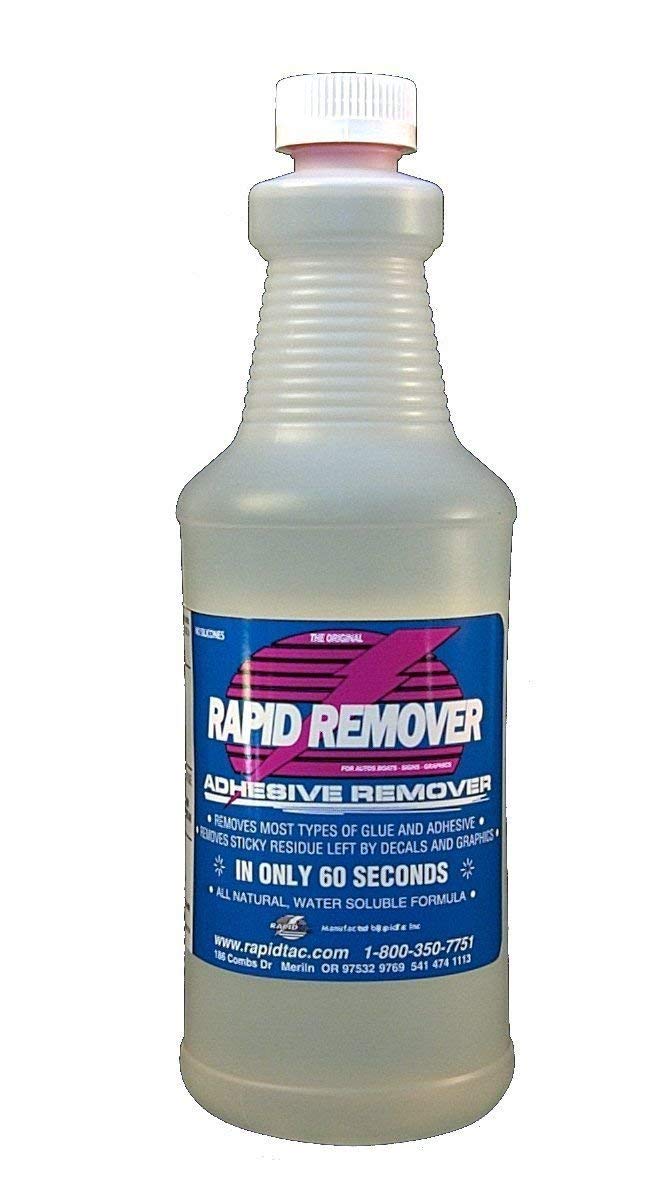
Removing adhesive from vinyl can be a daunting task, but with the right technique it can be done quickly and easily. The first step is to scrub the adhesive with a damp rag or cloth. This will help to loosen up the adhesive so it can be removed more easily. Be sure to use a gentle pressure to avoid damaging the vinyl. If the cloth fails to remove the adhesive, then you can use a mild soap and water solution.
Apply the solution to the adhesive, let it sit for a few minutes and then scrub the adhesive with a rag or cloth. This should help to break up the adhesive. If the soap and water solution does not work, you can try using a commercial adhesive remover. These can be used to dissolve the adhesive and make it easier to remove. Finally, you can use a vinyl adhesive remover specifically designed for this purpose. These removers work by softening the adhesive and making it easier to scrape off. With the right technique, you can successfully get adhesive off your vinyl and have it looking like new again.
How to make money with adhesive vinyl?
Removing adhesive vinyl can be difficult, but if done properly it can save you money. To remove adhesive vinyl, you’ll need a few basic tools: a heat gun or hair dryer, a razor blade or box cutter, and a plastic scraper. Start by warming up the vinyl with the heat gun or hair dryer. Heat causes the adhesive to loosen and makes it easier to scrape off. Once the adhesive has softened, use the razor blade or box cutter to scrape it away from the surface.
Use the plastic scraper to help remove stubborn pieces of vinyl. Work slowly and carefully to avoid damaging the surface underneath. Making money with adhesive vinyl is relatively easy. You can purchase adhesive vinyl in bulk from craft and hobby stores, or from online retailers. You can then use the vinyl to create custom designs for a variety of surfaces. You can sell these custom designs as wall art or decals for cars, windows, or other surfaces. Once you have the right tools and supplies, you can start making money with adhesive vinyl right away. With a little creativity and some hard work, you can make a good profit by selling your custom designs.
What adhesive do I use on vinyl?
When it comes to removing vinyl adhesive, you need to know what kind of adhesive was used in the first place. Depending on the type of adhesive, the method of removal can vary. Generally, vinyl adhesive is a two-part epoxy glue, but vinyl tiles may also be held in place with acrylic latex or solvent-based adhesives. If you are unsure of the adhesive type, you can perform a heat test by using a heat gun. Epoxy glue will begin to soften and become more pliable at higher temperatures, while acrylic latex and solvent-based adhesives will remain rigid and harden.
The best way to remove vinyl adhesive is to use a scraper and a removal solvent. A small amount of the solvent can be applied to the adhesive, which should loosen its hold on the vinyl. You can then use a putty knife or a razor blade to scrape it away. If you have a large area of vinyl adhesive to remove, you can try a heat gun set to a low temperature to soften the adhesive. You can then scrape it off with a putty knife or razor blade. When removing vinyl adhesive, it is important to use the right type of adhesive. Make sure you know what kind of adhesive was used, and use the right removal tools to ensure the best results.
How to clean up adhesive residue from vinyl windows?
Removing vinyl adhesive from windows can be a difficult task if you don’t know the right techniques. Here are some steps on how to clean up adhesive residue from vinyl windows. First, use a scraper to scrape off as much of the adhesive residue as possible. Take care not to damage the window or the surrounding area. Next, if the adhesive is still present, apply a solvent like rubbing alcohol or nail polish remover to a clean cloth and use it to scrub away the remaining residue.
Make sure to use a gentle motion to avoid scratching the window. If the adhesive is still not coming off, try using a razor blade to carefully scrape it away. Make sure to use a light touch and keep the blade parallel to the surface of the window. Once the adhesive is off, rinse the window with a damp cloth and dry it with a clean, dry cloth. This will ensure all traces of adhesive are removed. Finally, if the adhesive still won’t come off, use a commercial window adhesive remover to get rid of it. Be sure to follow the instructions on the product label to ensure the safety of your windows and the surrounding area. With the right technique, you can easily remove vinyl adhesive from your vinyl windows.
How to foil adhesive vinyl?
Removing adhesive vinyl can be a tricky process, but with the proper steps, you can get your surfaces looking clean and new in no time. One of the most effective methods for removing adhesive vinyl is to use a foil remover. To begin, you’ll need to heat up the vinyl with a heat gun or blow dryer. This will cause the adhesive to soften and make it easier to work with. Once the adhesive is softened, you can begin to carefully lift the edges of the vinyl with a squeegee or plastic scraper.
Be sure to use a gentle touch, as you don’t want to damage the surface beneath. Once you’ve gotten as much of the vinyl off as you can, you can then use a foil remover to get rid of any remaining adhesive. Simply spread the remover over the adhesive and let it sit for a few minutes before wiping away with a cloth or paper towel. Repeat this process until all of the adhesive has been removed. With a little bit of time and effort, you can easily remove adhesive vinyl and get your surfaces looking like new.
Does vinegar remove vinyl adhesive?
Removing vinyl adhesive can be a tricky task. Fortunately, vinegar can be used as a natural way to tackle this job in a safe and efficient manner. To use vinegar to remove vinyl adhesive, you will need white vinegar, a sponge or cloth, and a scraper. Begin by saturating the affected surface with the white vinegar and allowing it to sit for a few minutes. The vinegar should soften the adhesive, making it easier to scrape away.
Using the cloth or sponge, rub away any remaining adhesive. If any adhesive remains, you can repeat the process of saturating the area with vinegar and allowing it to sit. After the adhesive has been removed, you can clean the area with water and a mild detergent. This will help to remove any vinegar residue and keep the area free of odors. In summary, vinegar can be used to successfully remove vinyl adhesive. It is a safe, natural, and effective way to tackle this project.
Will Goo Gone ruin vinyl?
Removing vinyl adhesive can be a challenge, but with the right techniques and products, it can be done. One product that may help is Goo Gone, a citrus-based cleaner. It is often used to remove sticky residue, such as adhesive. But is it safe to use on vinyl? In general, Goo Gone is safe to use on most vinyl surfaces. However, it is important to test a small area first to be sure it won’t damage the material.
If you’re nervous about using Goo Gone, another option is rubbing alcohol or a store-bought adhesive remover. Before using any product on the vinyl, make sure to clean the area first. Dirt and debris can scratch the surface and make any adhesive removal job harder. When using Goo Gone, it is best to apply it to the adhesive directly, not the vinyl surface. Let it sit for a few minutes then gently scrape off the adhesive residue with a plastic scraper. Always wipe clean the area afterwards with a damp cloth and then dry it off. Overall, Goo Gone can be used to remove adhesive from vinyl, as long as it’s done carefully. Test a small area first and make sure to clean the surface and use the product correctly. With the right technique, you can easily remove the adhesive and restore the vinyl back to its original state.
Does acetone ruin vinyl?
Removing vinyl adhesive can be a tricky task. Acetone is often used as a solvent to help remove adhesives, but it can also be damaging to vinyl. Acetone can strip away the protective coating on the surface of vinyl, leaving it more vulnerable to scratches and other damage. If you do choose to use acetone, it is important to only use it on small areas, and be sure to clean the area thoroughly afterwards with a cloth and mild soap and water. It is also important to test a small area of the vinyl beforehand to make sure that the acetone will not damage it.
If you are not sure, it is best to avoid using acetone at all and use other techniques to remove the adhesive. For example, you can use a putty knife to scrape away the adhesive and use warm water, a cloth and a mild detergent to clean the area. Overall, acetone can be very damaging to vinyl, so it is important to be very careful when using it to remove vinyl adhesive. If at all possible, it is best to avoid acetone and use other solutions instead.
How do I remove adhesive from Cricut vinyl?
Removing adhesive from Cricut vinyl can seem like a daunting task, but there are several methods you can use to get the job done. One of the most common methods is to use a heat gun or hairdryer to heat up the adhesive, making it easier to peel off. Start by heating up the edge of the adhesive and then carefully use a sharp tool such as a razor blade or exacto knife to separate it from the vinyl. Be sure to use caution and start slowly to avoid damaging the vinyl. If a heat gun isn’t available, you can also use a combination of rubbing alcohol and warm water to remove the adhesive.
First, mix the rubbing alcohol and warm water in a bowl or spray bottle. Then, apply the mixture to the adhesive and let it soak for several minutes. Finally, use a cloth to gently rub away the adhesive. Another option is to use an adhesive remover spray. Spray the adhesive remover on the adhesive and let it soak for several minutes. Then, use a cloth or paper towel to carefully rub off the adhesive. Finally, you can use a commercial adhesive remover. Most commercial adhesive removers will require you to follow the instructions on the package, so be sure to read and follow the directions carefully. No matter which method you choose for removing adhesive from Cricut vinyl, it’s important to be patient and work slowly. With a bit of patience and persistence, you’ll be able to remove the adhesive and get your vinyl looking like new.
How do you remove dried up adhesive?
Removing vinyl adhesive can be a tough job, especially when it has dried up. But with the right approach, you can effectively remove the dried up adhesive. The first step is to soften the adhesive by using a heat gun or a blow dryer. Make sure to keep it at a safe distance and don’t overheat the adhesive. Once it has softened, gently scrape it off with a putty knife or a razor blade.
This should help remove most of the adhesive. If there is still some adhesive left, you can try soaking a cloth in a mixture of warm water and liquid dish detergent. Rub this cloth over the dried up adhesive. This should help the adhesive to come off. In case the adhesive is still not coming off completely, you can try using a specialized adhesive remover. It is available in most hardware stores and is specially formulated to remove adhesive residue. Finally, make sure to clean the surface with a damp cloth to remove any remaining residue. With these steps, you can effectively remove dried up vinyl adhesive.
Is adhesive vinyl removable?
Many people wonder if it can be removed without damaging the substrate it’s adhered to. The good news is that adhesive vinyl is usually removable, depending on the type of surface it’s applied to and the type of adhesive used. Removing adhesive vinyl usually requires just a few simple steps. Begin by heating it up with a hair dryer or heat gun. This loosens the adhesive and makes it easier to peel off.
If there is any residue left on the surface, you can use rubbing alcohol, adhesive remover, or a scraper to remove it. Be careful to avoid scratching the surface, as it could damage it. If the adhesive vinyl is not coming off easily, you may have to use a more aggressive method. Try using a power washer or steam cleaner to loosen the adhesive. Be sure to wear protective clothing, as these methods can be dangerous. To prevent adhesive residue from sticking to the surface, you can use wax paper or plastic wrap to cover the area before applying the vinyl. This creates a barrier between the adhesive and the surface, making clean-up much easier. Overall, adhesive vinyl is typically removable. With the right tools and a little bit of patience, you can easily remove it without damaging the surface.
